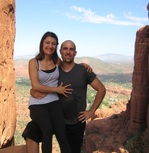Neda & I often reflect on our travel adventure and wonder how much we changed through the process. Did we become more relaxed in the face of stressful situations? Are we more comfortable with the unknown? It is hard to quantifiably measure such things. Certainly as we have returned into the flow of everyday life we notice those old ego habits we had hoped perhaps to leave behind. We can still be small minded, still get caught up in the dramatic stories we create, still be myopic and miss the big picture. It feels a bit like the title of John Kabit-Zinn’s wonderful mindfulness book, “ Wherever you go, there you are."
And yet things are different for us. We have relationships to the world we never could have dreamed of and a context to place our experience that makes it so much richer than before. And anytime we might forget these lessons, our trip seems to echo up from the past to remind us.
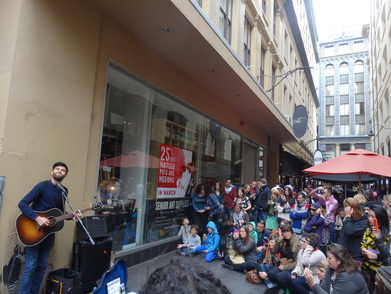 Street Performer in a Melbourne alley Street Performer in a Melbourne alley One such example of this occurred a few months ago while we were driving over to my brother’s house listening to our satellite radio. The voice resonating through the speakers tickled not just our eardrums, but our temporal lobes as well. Suddenly we were transported back to March of last year where we spent an action packed day walking the alleyways of Melbourne. We had been checking out the various graffiti street art of the city when we stopped to listen to a talented street performer who crooned away while selling CDs from his open guitar case below. His voice had a unique twang that we had admired at the time…and suddenly were hearing in our car halfway across the world!
Sure enough, a quick look back at our pictures confirmed that it was the same guy! His name is Mike Rosenberg and he’s been playing on streets around the world to help finance his music, put out under the moniker “Passenger”. And just recently he made it big, with his hit single “Let Her Go” topping the charts in countries around the world. And what song did we happen to record on that sunny day in Melbourne? Listen for yourself:
And here’s the studio version:
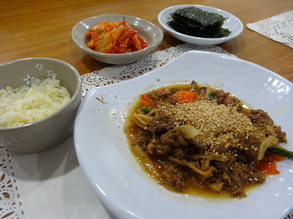 Mmmm...we miss Seoul! Mmmm...we miss Seoul!
The Passenger story is just one example of our trip reminding us of the depth of experience we gained traveling the globe. Other examples come to us anytime we go out to eat our favorite ethnic food. When we go out to Korean BBQ in Lansdale we can joke with the waiters about the districts of Seoul where they are from. Just recently a trip to a local Vietnamese restaurant led to the owner reminiscing with us about his days in Saigon (and comping us some spring rolls as well!). We speak in Thai to our waitresses and admire their hill tribe produced dresses and then later talk to an Indian friend of ours about our experiences in his hometown of Calcutta, which he returns to in a few months.
Then there is the recognition that it was not only us who was changed by this trip. The labor of love that is this blog affected others as well. This was very sweetly and poignantly demonstrated to us a few days ago, when my old friend and co-worker Lindsey Harvill prepared to depart for her own adventure. She wrote on Facebook recently:
“Backpacking through Thailand with Aldo Merino - just ourselves and these tiny packs!! Special thanks to Neda Fields and Jeff Fields who inspired me by sharing their insights on their blog during their world travels. I learned so much about the importance of respect for the culture and environment and how to fully embrace all aspects of a new experience.”
So what do we make of all of this? Perhaps it’s helped us to realize that transformation isn’t necessarily measured in complete overhauls to one’s personality. It’s measured in the smile that comes to your face when a song reminds you of a beautiful day. It’s measured in expressing interest and knowledge in a stranger’s homeland and finding that suddenly you are no longer strangers. It’s measured in how much we inspire others and the good that they then go on to do in the world.
Is it quantifiable? No, not really. But perhaps all these stories urge us to not be too hard on ourselves for the explicit ways we have not transformed by reminding us of the subtle ways in which we are ALWAYS transforming.
Zen thought is rife with the theme of interconnectedness, sometimes called dependent co-origination. The basic idea is that everything in the world arises together and only exists together through a delicate balance of certain causes and conditions. As any one thing changes, so does everything else in the world. Perhaps the most famous metaphor in Buddhist thought for this idea is Indra’s Net. Francis Harold Cook, in his book Hua-Yen Buddhism: the Jewel Net of Indra, describes the net as follows:  Indra's Net - Copyright Gail Atkins "Far away in the heavenly abode of the great god Indra, there is a wonderful net which has been hung by some cunning artificer in such a manner that it stretches out infinitely in all directions. In accordance with the extravagant tastes of deities, the artificer has hung a single glittering jewel in each "eye" of the net, and since the net itself is infinite in dimension, the jewels are infinite in number. There hang the jewels, glittering "like" stars in the first magnitude, a wonderful sight to behold. If we now arbitrarily select one of these jewels for inspection and look closely at it, we will discover that in its polished surface there are reflected all the other jewels in the net, infinite in number. Not only that, but each of the jewels reflected in this one jewel is also reflecting all the other jewels, so that there is an infinite reflecting process occurring."
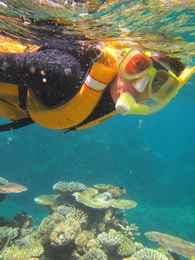 Neda on the reef Enter the Great Barrier Reef. Composed of billions of tiny organisms called coral polyps, the reef is the largest single structure made by living organisms and the only one that can be seen from space. As Neda & I swam through the reef and witnessed its dazzling hues, it occurred to us that it is a living embodiment of Indra’s jeweled net. Literally billions of animals swim in an intricate dance that is both awe-inspiring and yet also extremely delicate. It took millions of years for the reef system to form - for the net to be woven as it were. But current threats to the reef show us that just a few of the jewels breaking are enough to make them all stop shining.
The threats are numerous. Shipping traffic over the reef is quite high and accidents occur too often. The last major accident was in 2010 when the Chinese bulk coal carrier Shen Neng 1 was traveling outside the regulated shipping lane and struck the reef, scraping along its surface and creating a 3 kilometer scar where no marine life lives anymore. 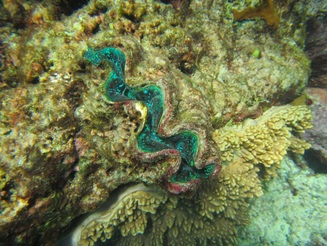 A beautiful giant clam
With the Australian economy booming from coal exports sent to support China’s voracious industrial machine, shipping accidents will only increase. The Australia coal industry has plans to build another 9 coal ports along the Australian coast, increasing even further the traffic passing through the reef. Many of these ships use a chemical called Tributyltin, which preserves the condition of ship hulls, but is toxic to the sea life it touches. The increased traffic will also increase the oil spills that occur on the reef – there have already been 283 spills on the reef since 1987.
Global warming is another threat to the reef that is already occurring. Warming waters are killing off the algae that populate the coral (which are what give the reef its vibrant colors). As one might expect from the Indra’s net analogy, the damage to the algae results in the death of the animals that use it as their food source and so on down the food chain until all that is left are “bleached” corals devoid of color and of life.
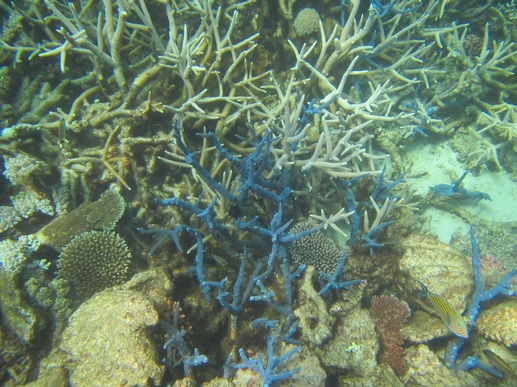 bleached corals? The most iminent threat comes from the burgeoning numbers of Crown of Thorns starfish attacking the reef. These bad boys latch onto coral and eat its tissue. A high enough concentration and whole sections of the reef can be rendered lifeless. The high numbers of the starfish are believed to stem from the agricultural run-off in the area feeding the algae that the Crown of Thorns starfish eat.
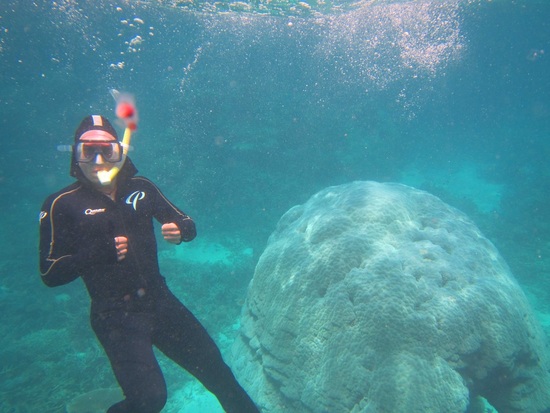 Jeff with a 3,000 year old "boulder coral". These guys take hundreds of years to build each subsequent layer... 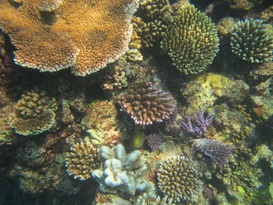 All in all, I know this paints a grim picture for the reef and is perhaps a rather sad illustration of Indra’s net. Experts seem to believe that it is quite possible the reef will only be a natural wonder enjoyed by the next generation or two humans before becoming part of the history books. According to a 2012 study by the National Academy of Science, since 1985, the Great Barrier Reef has lost more than half of its corals with two-thirds of the lost occurring from 1998 due to everything discussed above. But that doesn’t mean there isn’t something you can do, regardless of the odds. For more information on positive change you can make, click here.
Indra’s net is a powerful concept that can be explored at multiple levels. The ecological example of the reef proves how interconnected our lives are with the billions of lives that surround us. Perhaps you can’t singlehandedly save the reef, but think about how you can apply the analogy to other parts of your life. You are a jewel in the net, reflecting outward to all the other jewels. Perhaps the smile you give a stranger changes her day for the better and affects her husband, kids, co-workers, etc… In what other ways can you spread light through the net instead of watching as the darkness comes?
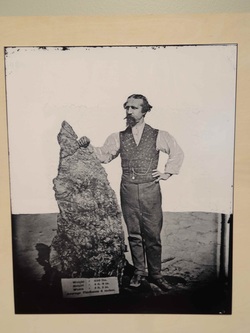 The biggest nugget of gold Melbourne is a city born out of gold. Originally founded via settlers from Tasmania, the city was a small farming settlement until the discovery of gold inland in the state of Victoria. The gold rush led to the city doubling in population within a year and continuing to grow and boom for nearly 40 years – a time when Melbourne was known as a “working man’s paradise”. By the end of the boom in the 1890’s Melbourne’s population was nearly half a million and for a time it was the 2nd largest city in the British Empire after London. For me however, Melbourne was more interesting in its connection to our personal history because Mick McKiterick lives there. Mick was a good friend of mine when I studied abroad at Utrecht University in 2002.
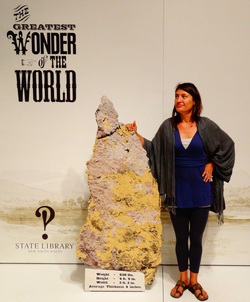 Neda does her version of the pose Back then I was studying philosophy with several mates in Utrecht and Mick was studying law. We had great times contemplating philosophical and ethical issues while coming of age in the charismatic Dutch city. I most recently had seen Mick in 2005 when a visit to St. Louis saw us heading to a pub-crawl together with good friend Josh Finnell, who had also studied at Utrecht with us as well. On that fateful evening, I would meet a charming Bulgarian girl who liked to sing karaoke and throw back shots of tequila. Add to that her intoxicating laugh, quick smile, and generous heart and it wouldn’t be long before I asked her to marry me…and the rest is history! By being there on that special night, Mick has always had a place in Neda & my relationship mythology. To add to this dynamic, it is a particularly exciting time in Mick’s life as well as he is due to marry fiancée Marlene this coming May. Sufficed to say, we were excited to reunite on his home turf and meet his wife-to-be.
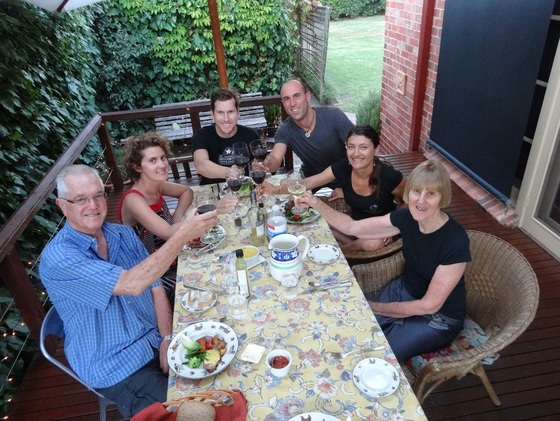 Dinner in Echuca with Mick, Marlene, Terry, and Allison 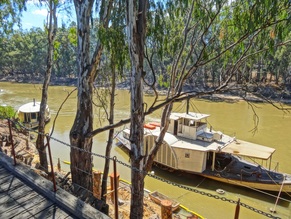 Old Steamer on the Murray River The adventure started with a weekend trip out to Echuca, Mick’s home-town. There his Mom Allison treated us to delicious baked cookies and cakes (thus the sugar in the title). Both Allison and Mick’s Dad Terrence opened up their home to us and we shared delicious food and good conversation. Marlene, Mick, Neda and I also floated down the Murray River while enjoying the Aussie Labor Day.
With the weekend ending, Mick & Marlene generously loaned us their car and their camping equipment and we set off on the Great Ocean Road along the coast of Victoria. Built as a way to give jobs to returning WWI servicemen, the road winds its way down the coast passing stunning sea formations at multiple points. Hikes in the area feature the history of the Shipwreck Coast (over 50 ships were lost in the area between 1836 to 1940) as well as the beautiful limestone and sandstone rock formations of the Twelve Apostles, the Loch Ard Gorge, the Grotto, and the London Bridge. The Loch Ard Gorge is named for a ship that wrecked there in 1878. The only survivors were a ships apprentice who was washed up into the gorge and then rescued a woman who had also washed up on a piece of wreckage nearby.
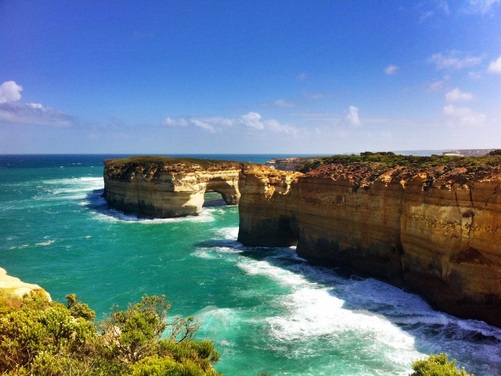 Loch Ard Gorge 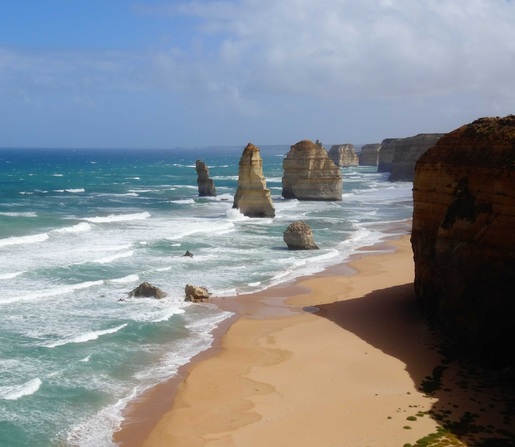 The Twelve Apostles 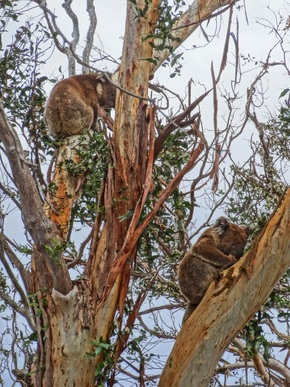 Koalas huddled in trees Another highlight along the Great Ocean Road was camping in the Cape Otway National Park. The campground itself at Blanket Bay was filled with flies and not the most comfortable, but on the way out we saw heaps of cuddly Koala Bears huddled in the trees. But most of them were seemingly passed out as they nestled in the trees. Why you ask? It turns out that koalas only eat eucalyptus leaves, an ecological niche that they have cornered because the leaves are tough, oily and difficult to digest. This turned out to be a particularly good niche for them because the leaves act as a mild narcotic to the koala’s biology which means they are basically hanging out high all day long. With this in mind we felt lucky to see a few of the critters wake up out of their daze and forage along the branches for another “hit”.
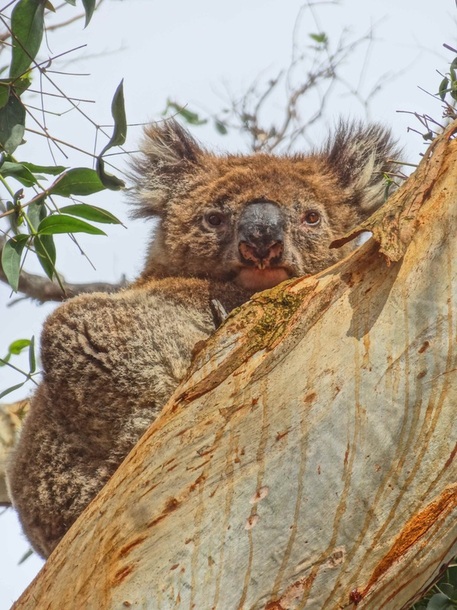 Look at that koala face! This one loved the camera! 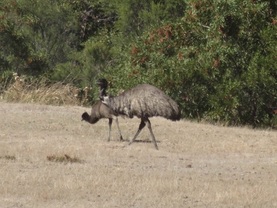 Emus at Grampians Natl Park Neda and I camped in Port Fairy at the end of the Great Ocean Road and had a romantic evening of ice cream and strolling around before waking early the next morning to head off to the Grampian National Park. We passed through the Brambuk Cultural Centre where we learned a bit about the aboriginal population who used to live in the park’s area and also saw some Emu in the wild. Then we pounded off on some great walks including the Pinnacle Walk, which passes through the Australian “Grand Canyon” on a fun rock-hopping hike. We also enjoyed the Boroka and Reeds Lookout walks and were dazzled at the end of the day by the sun piecing the mist as it shined down on majestic McKenzie Falls.
That night we bedded down at Trooper’s Creek campsite and some local kangaroos came around looking for some chow. Neda and I gave them some shredded carrots and got up close and personal with these fascinating marsupials! The next morning we headed to Hollow Mountain for a morning hike. We climbed over rocks formed under water millions of years ago and lifted up during the formation of the continent. The water had left fluid marks on the rocks that made this hike incredibly unique and interesting to explore. The morning sun also shone wonderfully off the tangerine orange cliffs, making for some great photos! 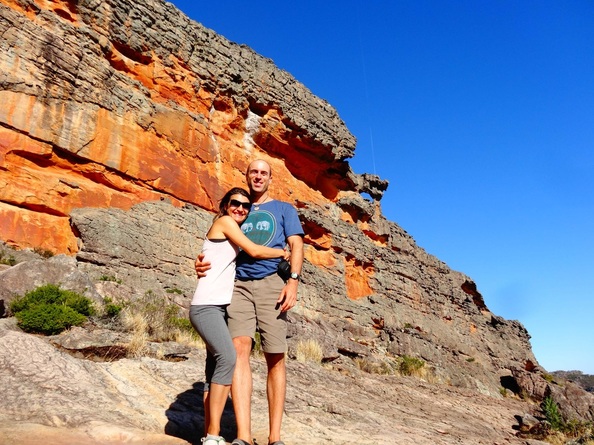 On top of hollow mountain 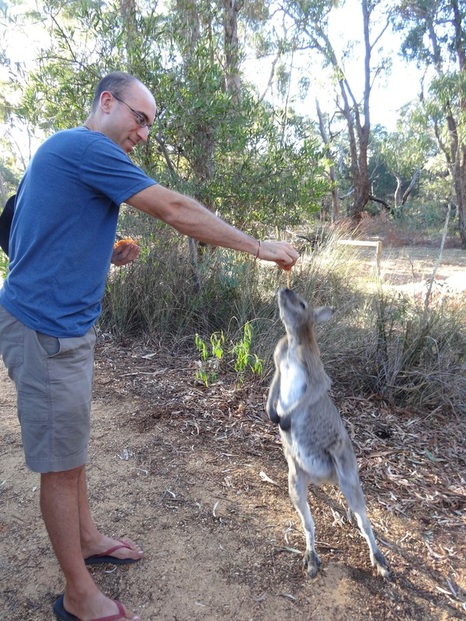 Feeding the roos! 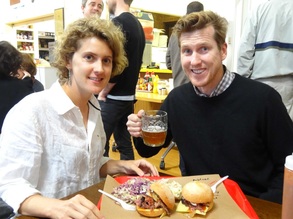 Mick & Marlene with some BBQ We returned to Melbourne to a delicious homemade pesto pasta dinner with our generous hosts – Mick and Marlene – and a wonderful evening of chatting and catching up. Saturday morning, Mick took us to his yoga studio for a great class to start off the weekend and after we explored some of the hip Melbourne neighborhoods. That night we celebrated Mick’s birthday at the local bowling club (rain made for no bowling) which had delicious BBQ (the closest to Texas we’ve had)! We were amazed at the moist smoked brisket at Fancy Hanks and painfully missed our old hometown of Austin. The next day, we explored Federation Square and enjoyed Thai and Greek festivals, Chinese dumplings, and many cute lanes (Aussie for alley) decorated with street art, and packed with hidden restaurants and bars and street performers. Mick and Marlene, thank you so much for your hospitality! It was solid gold!
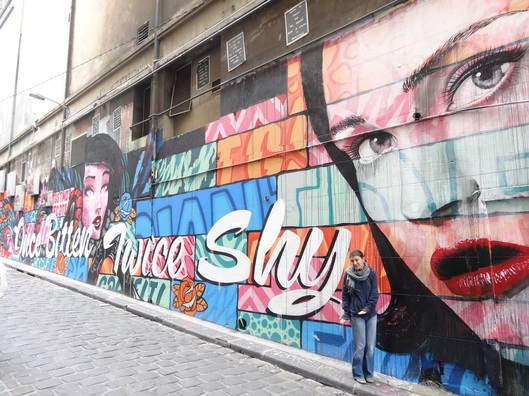 Hosier Lane Street Art
Sydney – can one place better epitomize mankind’s egregious sin as well as her capacity for redemption? In the middle of January 1788, the first fleet of settlement ships landed on the coast of the massive continent at Botany Bay, which Captain Cook had suggested as an ideal settling place when he explored there in 1770. Finding Botany Bay ill suited for settlement, Captain Arthur Phillip sailed down the coast a bit and found that Cook had overlooked the area known as Fort Jackson. Far from a tiny inlet, as Phillip sailed inward he discovered one of the greatest natural harbors in the world and the city of Sydney was born.
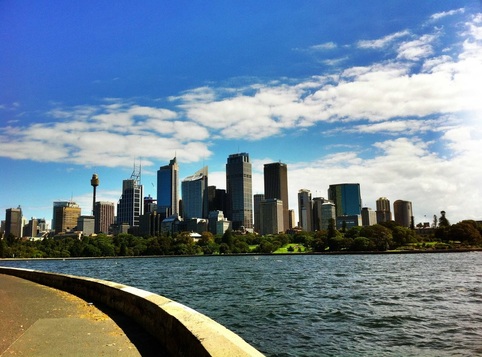 Sydney on a beautiful sunny day 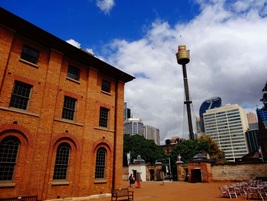 Hyde Park Barracks from convict times A full half of the contingent of 1,500 settlers were convicts sent from Britain. Why was Britain sending so many convicts to Australia? The answer is twofold. First is the so-called “Bloody Code”, the legal system in Britain at the time that carried the death penalty for over 222 crimes, including cutting down a tree, stealing goods worth 5 schillings (scarcely above the cost of a loaf of bread), or stealing fish from a river. The legal system was so draconian (particularly towards the poor) that magistrates often downgraded the punishment to transportation rather than death in an effort to circumvent the code. Convicts were also sent for political reasons. For example, nearly a 1/3 of the early convicts sent to Australia were Irish Catholics whose land had been taken during the Protestant “settlement” of Ireland (see the Fields of Indulgence Post “Weeping Buddha, Smiling Buddha” for more insight into this issue). At that time in Ireland, strict laws prevented Catholics from traveling more than 5 miles from their home, entering university, or being able to vote. Many were forced to a life of crime to survive – crimes punishable by transportation off the island or death. Other convicts sent included pirates, pickpockets, and women with “loose morals” ( who often were just women who had intentionally offended authorities in order to travel with their husbands). The 2nd reason for the large shipment of convicts to Australia (nearly 160,000 people in total between 1788 and 1868, when penal transportation ended) was that a certain colony now called the United States of America had rebelled and stopped accepting the transportation of prisoners that England had previously sent to its shores.
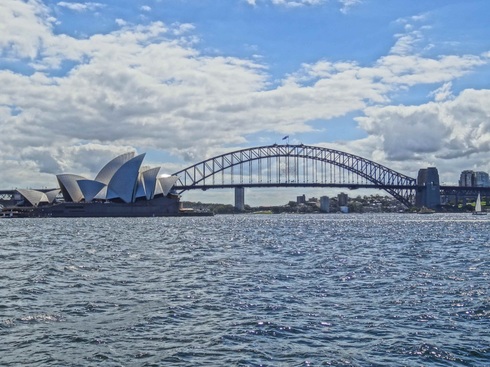 Sydney Harbor Bridge and Opera House The sins of Sydney’s past didn’t stop with the largely unjust transportation of convicts, but also lie in the terrible way they were treated in the first years. Many arrived to the continent half starved and quickly died while those who survived could be beaten mercilessly or hung for minor offenses while the female population of convicts was routinely sexually exploited.
But perhaps life for the convicts wasn’t so bad compared to the treatment of the Aboriginal populations. Having declared the land “terra nullius” (land belonging to nobody) due to the lack of agricultural activity present on it, the British essentially justified the invasion and destruction of the native population, who had lived there for an amazing 60,000 years prior to any Europeans arriving. The Aboriginal population consisted of over 250 distinct tribes, each with different languages and customs. Captain Cook, upon his discovery of the natives, speculated they might be happier than Europeans. Maybe it’s not surprising when the average aboriginal week consisted of about 20 hours of hunting/gathering with the rest of the time devoted to arts, music, and social activity. Granted living conditions were arduous, but could Europeans have learned something from this simple living rather than just destroying it for their agrarian machine?
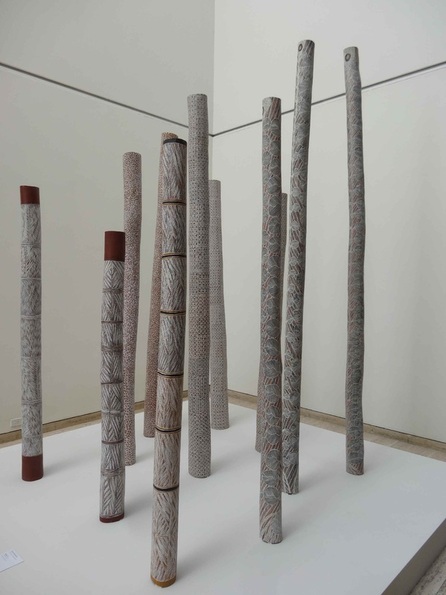 Didgeridoo art display in Museum of New South Wales Unfortunately, early friendly reactions towards the Europeans by the Aboriginals (who thought the settlers were ancestors returned as ghosts – after all they were quite white) quickly turned sour as the colonists intentions became clear. There was to be competition for resources and land and the locals were ultimately considered to be in the way. Early efforts by Governor Phillip to mediate with the locals ( most notably by kidnapping, acculturating and later befriending an Eora tribesman named Bennelong) eventually fell apart as smallpox decimated the local population, leaving hundreds of native bodies floating in the harbor in the early years. As Europeans continued to settle on Aboriginal land, guerilla warfare broke out and hostility would rule the day from then onward. 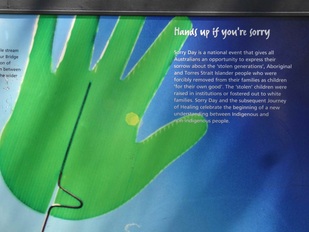 National Sorry Day This violent attitude towards the Aboriginal population may have reached its most disgraceful point between 1910 and 1970, when nearly 100,000 children were forcibly removed from their Aboriginal families to be placed in mixed-race children in orphanages, boarding schools or white homes. The idea was to promote assimilation, but the end result was to cut the children off from their culture, leaving them alienated both from their own people and the foreigners with whom they were thrust. This “stolen generation” has left a gaping wound in aboriginal culture today and has left many native people disenfranchised, unemployed, and isolated as they have been moved off the land they traditionally roamed upon to be put onto government-run reserves (if your from America this sounds familiar). In fact, it wasn’t until the 1960s that Aboriginal people were even included in the national census and began making strides towards equality in the eyes of the law.
We’ve taken some time to examine the sin at the heart of Sydney’s history, but there are tales of redemption as well. By 1822 nearly half of the convicts who had been transported established themselves as landowners or tradesmen once earning their freedom through good behavior. James Squire, a convict transported on the first fleet for stealing several chickens, was to become the first man to cultivate hops on the continent. Squire ran a tavern, a butcher shop, and a credit union and his death in 1822 saw the largest funeral ever held in the colony, completing his move from “shame to fame”. His name is now attached to a brand of craftbrews in Australia. In fact, the move from “shame to fame” is something that many Australians take pride in today. It is considered quite “vogue” to have had a convict in your family history. It is proof that your ancestors turned things around in this new world down under. In regards to the Aboriginal population, redemption is a continuing process whose end result is far more murky than the turnaround the convicts achieved. The government has now recognized a National “Sorry” Day (later renamed the National Day of Healing) that has seen both whites and aboriginals joining together to recognize the injuries done and start the path towards healing. Though much can be said for the power of an apology, the question remains how a nation can ever recover from such violence? 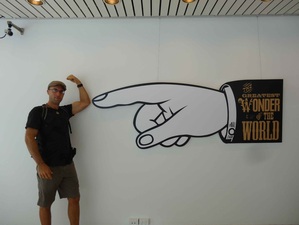 Goldrush Life Exhibit For Neda & me, Sydney was a welcome return to the big city after the rural adventures in New Zealand. Upon arriving, our generous couchsurfing host Gav cooked us up some kangaroo steaks (didn’t think I would eat a kangaroo prior to seeing one live in the wild!) and introduced us to the city. The next few days saw us walking the city as we explored the beautiful botanical gardens, the Hyde Park Barracks (where convicts were originally housed in the colony), and a fascinating exhibit at the Library of New South Wales on the Goldrush in Sydney. The discovery of gold in 1851 in Victoria would launch a massive goldrush on the continent, bringing in the wealth necessary to develop Sydney and Melbourne into the large cosmopolitan cities they are today.
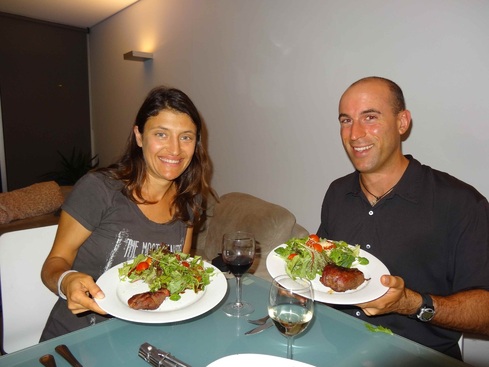 Kangaroo Steaks courtesy of our Couchsurfing Host - Gav We enjoyed some of that cosmopolitan spirit on our 2nd night in town with a visit to Victoria park for some slacklining with the locals followed by a hilarious improv comedy show at the University of Sydney, where we sampled the James Squire beer mentioned previously. Of course no visit to Sydney is complete without several different viewpoints of the architecturally stunning Sydney opera house and Sydney harbor bridge, which makes it the most beautiful harbor that we have ever seen. But beyond the bridge and opera house, the harbor is a truly massive affair, stretching 19km inland and providing access to many different areas via ferry. Neda and I took a day to explore one such area when we took the ferry to Manly beach and walked the harbor coastline from the Spit Bridge back to the city. We enjoyed sweeping harbor views as well as our first introduction to some interesting Australian wildlife like the St. John’s cross spider and the big water lizards living along the coast.
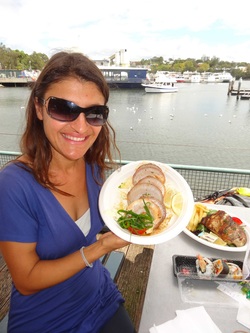 Fish market scallops We ended our time in Sydney with a visit to the local fish market where we sampled barramundi for the first time and delicious fresh scallops grilled in the shell! We also visited the wonderful museum of New South Wales, which features Aboriginal art as well as quirky exhibits displaying a variety of modernist and post-modernist art.
Our time in Sydney was a combination of appreciation for the society that has been built here and a feeling of deep loss for the civilizations that were displaced and destroyed. Still, Australia today is more multi-cultural than ever as it continues to work towards reconciliation with its first people, welcomes refuges from around the world and integrates its Asian neighbors into the cultural mix. It is a country working to fight its reputation as a “cultural backwater” by embracing the arts and globalizing its strong economy. It is a country that continues to strive towards a deeper awareness of the sins of its past while building a brighter future for all of its people. Redemption isn’t a tale that is told overnight, but rather a road that is laid brick by brick. There are many more bricks to lay, but at least the road is under construction.
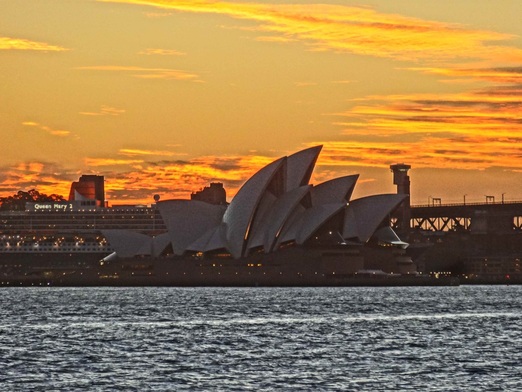 Sunset Cruise in Sydney
Dim Sum’s roots lay buried in Southern China where the ancient tradition of tea tasting was popular. As the silk road grew more crowded with travelers and people discovered that tea aided in digestion, it made sense to offer some snacks with the tea. Lucky for us, those snacks were so delicious and varied, that the tradition stuck and Dim Sum was born. Literally meaning, “touch the heart”, I think the Chinese may have had some inkling of how unhealthy these little delectable morsels were when they came up with the name – if you’re not moderate they literally will touch your heart!
But as we flew into Kuala Lumpur and got our first experiences of the city, we realized that the idea of dim sum really epitomizes the cultural smorgasbord found in the country. In addition to the indigenous Malay population, India and China have both been actively trading with the strategically located peninsula since around the 2nd century AD. By the 11th century Islam had spread across the country via trade and in the 16th century the Dutch established a strong presence, followed finally by the British in the 18th century.
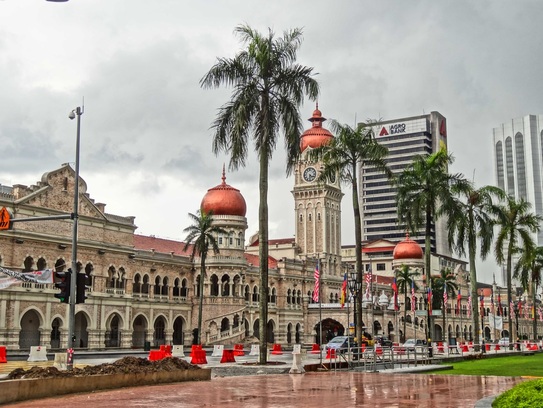 Sultan Abdul Samad Building after the afternoon downpour 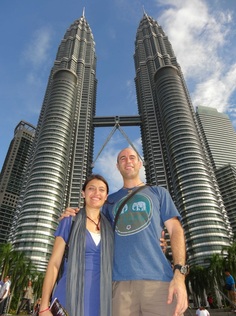 But the highlight of the city came in a pair. The Petronas Towers rise 1,500 meters in the air and seem almost like giant minarets visible from anywhere in the city. The towers are the home of the country’s national oil company, but also incorporate Islamic geometric principles as they rise in the shape of an eight-sided star. Under the towers sits an enormous mall while in their shadow is a large park with a wave pool - a playground for kids. All in all, it’s a wonderfully designed space, perhaps best appreciated from above. To do so, we headed to the nearby Trader’s Skybar, with views straight to the towers and attached park. As day turned to night, we watched the towers light up like shimmering crystals protesting the darkness. The sight of this architecture, turned into mesmerizing, incandescent sculpture as the night fell, was a true highlight. Add to that our first beer in 6 weeks (we didn’t drink while in India) and the night was complete!
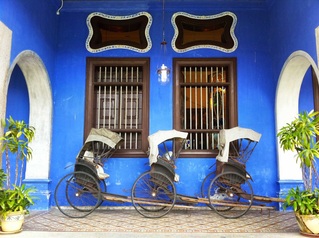 Cheong Fatt Tze Mansion After Kuala Lumpur we headed to the Cameron Highlands for adventures with tea (see our post about that here), before heading to the island of Penang, in the northwestern part of the peninsula. Penang’s history started to get really interesting in 1786 when the Sultan of Kedah ceded Penang to the British East India Company in an attempt to gain protection against Siam (though it didn’t work). The British established Penang and other small territories along the coast of Malaysia (called the “Straits Settlements”) to use them as free trade ports. As such, an enormous mixture of people combined there, making a veritable dim sum cart of cultures. There were the indigenous Malays, the Chinese (who had come in droves when tin was discovered in Malaysia), the Klings (southern Indians), and of course the Europeans. In addition, a new culture known as Pernakan was created out of the marriages of Malays and Chinese.
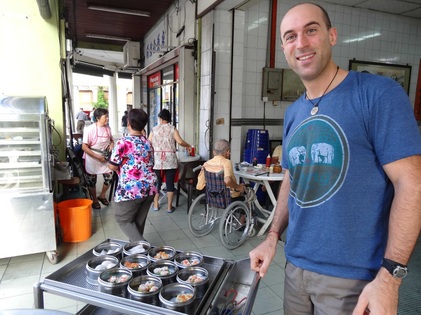 so many choices! 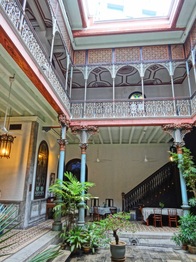 traditional atrium The mixture finds its apex in the delightful city of Georgetown on Penang. Old Chinese shop houses sit across Anglican churches (and a British fort) while Little India booms out music and the local Malays worship at the white-washed mosques. We stayed in a Chinese heritage house, formerly a shop house and family home all in one. It had a beautiful atrium in the middle - a necessity in Chinese Feng Shui, which believes that rain water must be able to enter the home as it symbolizes the coming of wealth. From there, we explored the city and island and its many gustatory delights. Each morning would find us participating in the ritual of dim sum, where a pot of loose leaf Chinese tea was served as women would cart around trays with little dishes of goodies you could choose. Some of our favorites were the deep fried pork rolls, the Chinese white bun stuffed with chicken, egg, and mushroom, and the crab and sesame seed topped dumplings! When we were sated on meat, the city also had a variety of economical vegetarian buffets, where you could fill up your plate with healthy greens and delightful tofu dishes for just a few dollars.
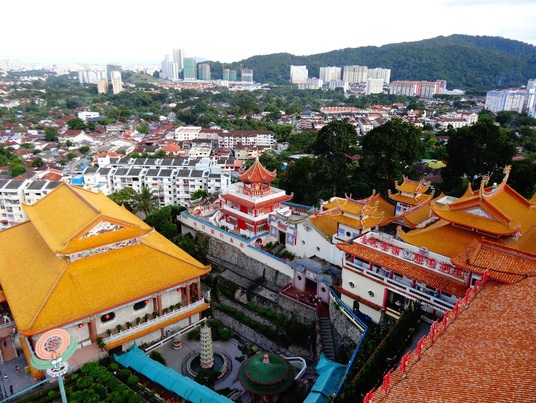 Kek Lok Si Temple with Penang in the background 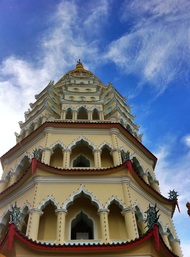 Pagoda of 10k Buddhas After our big breakfasts, we would do some sightseeing before retreating back to our wonderful room for a respite from the smothering heat. The one day we rented a motorbike and braved the heat, however, we did manage to see many of the sites outside of Georgetown. This included Wat Chayamangkalaram, a massive Thai temple with a huge reclining Buddha inside, and Kek Lok Si Temple, the largest Buddhist temple in all of Malaysia. Kek Lok Si sports a massive statue of Kuan Yin (the bodhisattva of compassion) as well as the towering Pagoda of Ten Thousand Buddhas, which was designed in Chinese, Thai, and Burmese styles to represent the unity of the different types of Buddhism.
Perhaps most unique however, was Ban Kah Lan, or the snake temple, where many years ago monks had allowed the local venomous Wagler’s pit vipers to live on the grounds rather than kill them. Over time, this developed as the temple’s primary attraction and a visit sees the vipers not only on branches curving next to the altar, but resting on branches all over the trees behind the temple. Be warned that it’s good to visit during the day when the vipers are sleeping – a trip at night may be your last! 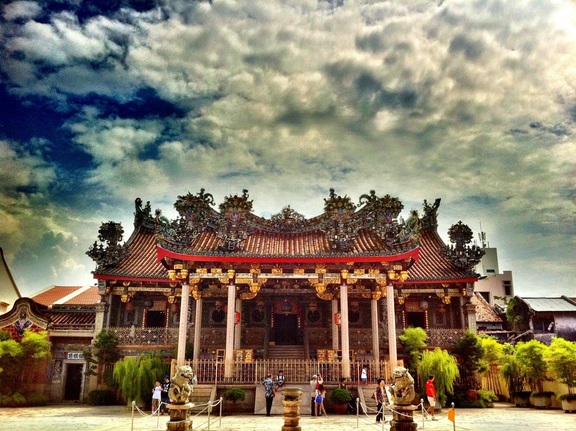 Khoo Kongsi Chinese Clan Temple The Chinese architecture in Georgetown was impressive as well. The Cheong Fatt Tze Mansion showed the opulence enjoyed by one of China’s richest businessmen at the turn of the 20th century. Nearby, the Khoo Kongsi temple and other clan temples have intricate carvings and statues meant to honor the clans of the immigrants who had moved there.
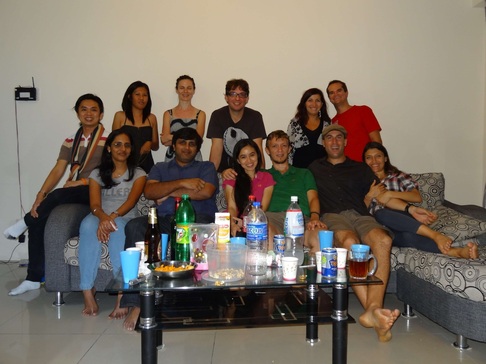 Christmas Eve CS Potluck! We also happened to be in Penang over the Christmas holiday and the friendliness of the locals was matched by the friendliness of the local Couchsurfing Community. Brian and Magda, a wonderful couple from Canada and Poland respectively, decided to host a Christmas Eve potluck for couchsurfers in the area. The evening was full of fun and conversation as we had travelers from Hungary, India, Romania, Spain, and locals all mixing to share food and experiences. The next day we all met up again for an Indian Christmas dinner and drinks. All in all, we loved our time in Malaysia as we got to choose all the goodies we wanted from our dim sum cart - good people, good food, and great cultural variety. Now we are in New Zealand, but on the way here we had an 11 hour layover on the Gold Coast of Australia. So why not hit the beach? We threw our bags in a locker, changed into our swimsuits and a 10 minute bus ride later we were having a great time riding the waves in the beautiful azure green water. 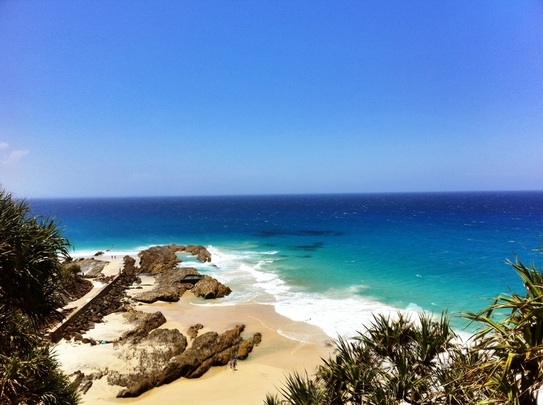 Best layover ever! Gold Coast Australia Our updates for New Zealand will be sporadic at best as we cruise our Toyota Estima with a futon in the back around the two islands! We hope to wrap up the purchase of the van in a couple days and in the meantime had a great New Year's Eve out on a beach house of our friends Chris and Lauren, who we have re-united with for the next week or so! You might remember them from Cambodia and Vietnam!
|
 Street Performer in a Melbourne alley
Street Performer in a Melbourne alley  Mmmm...we miss Seoul!
Mmmm...we miss Seoul! 
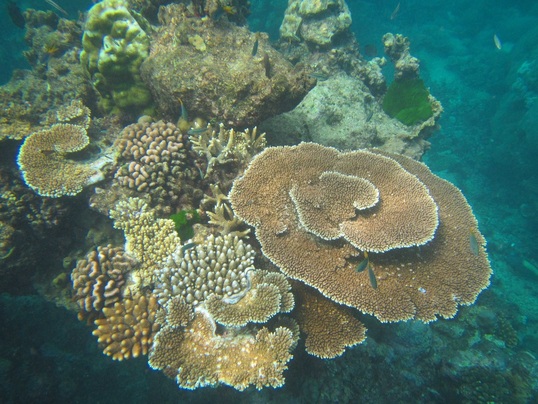

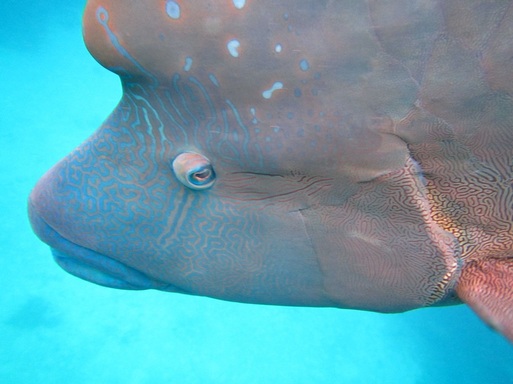




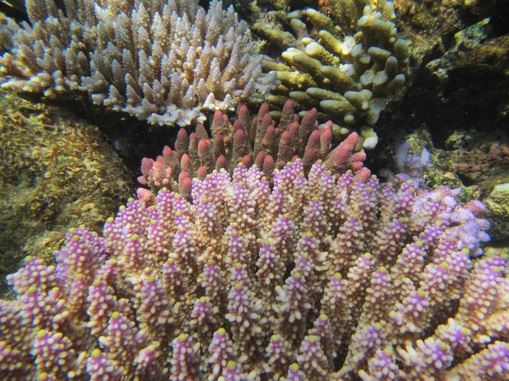
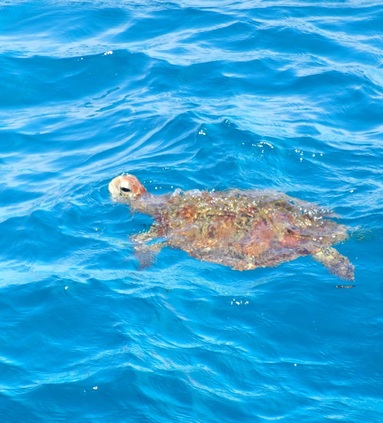









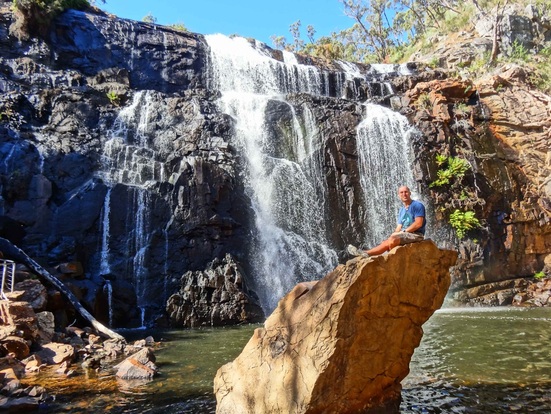











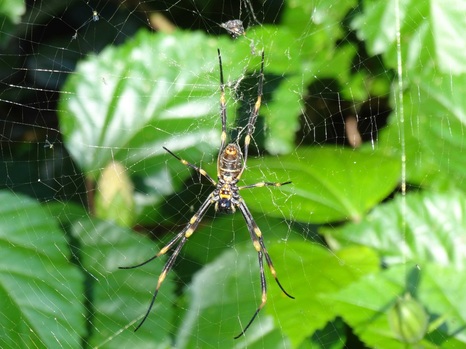


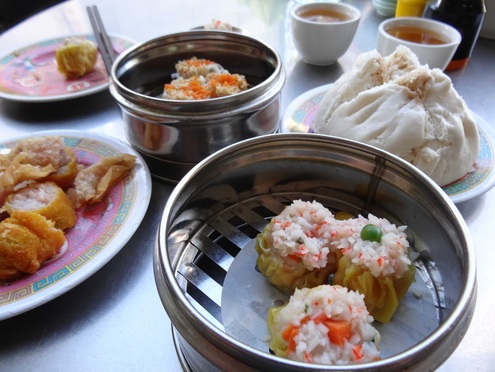


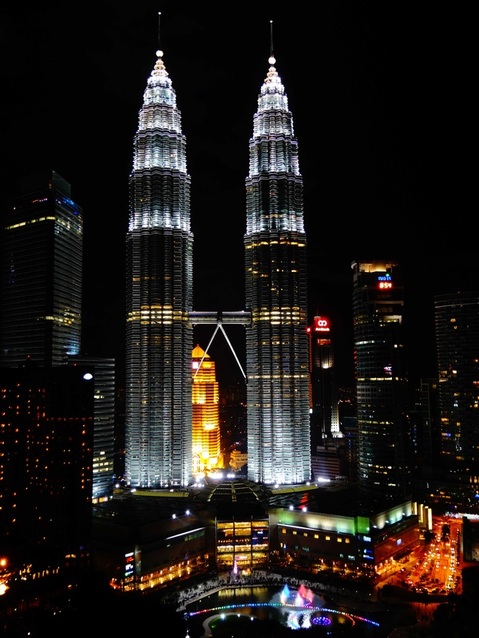





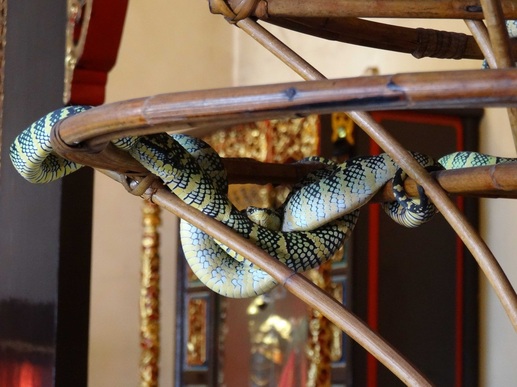



 RSS Feed
RSS Feed